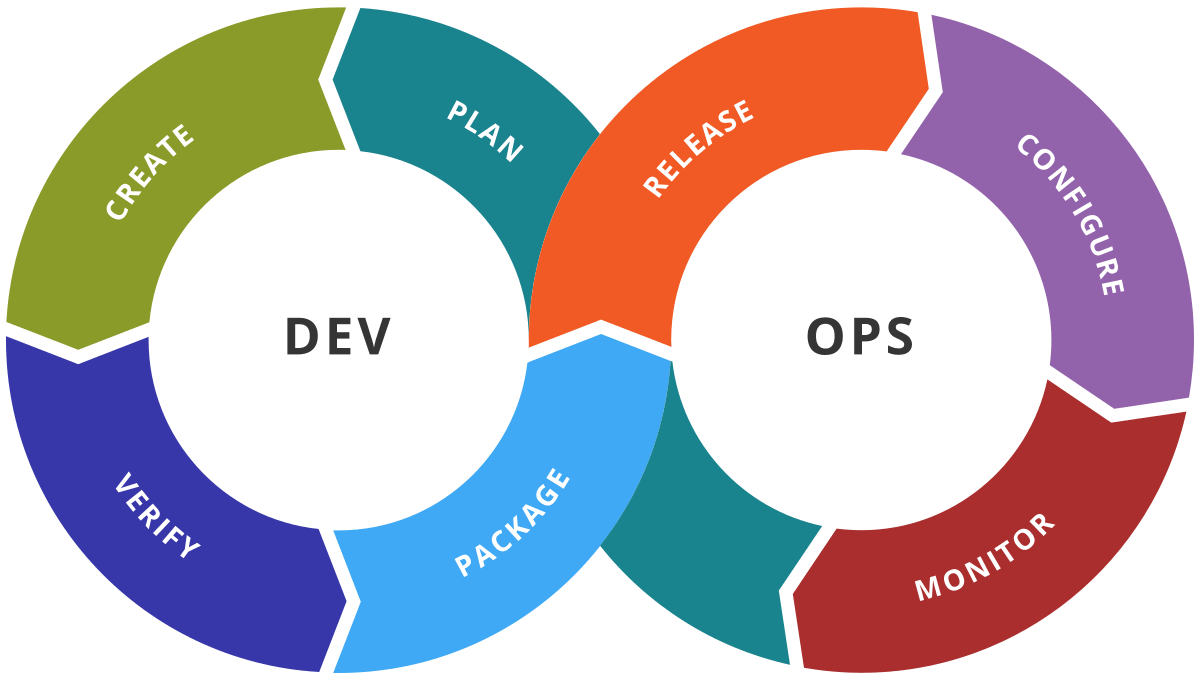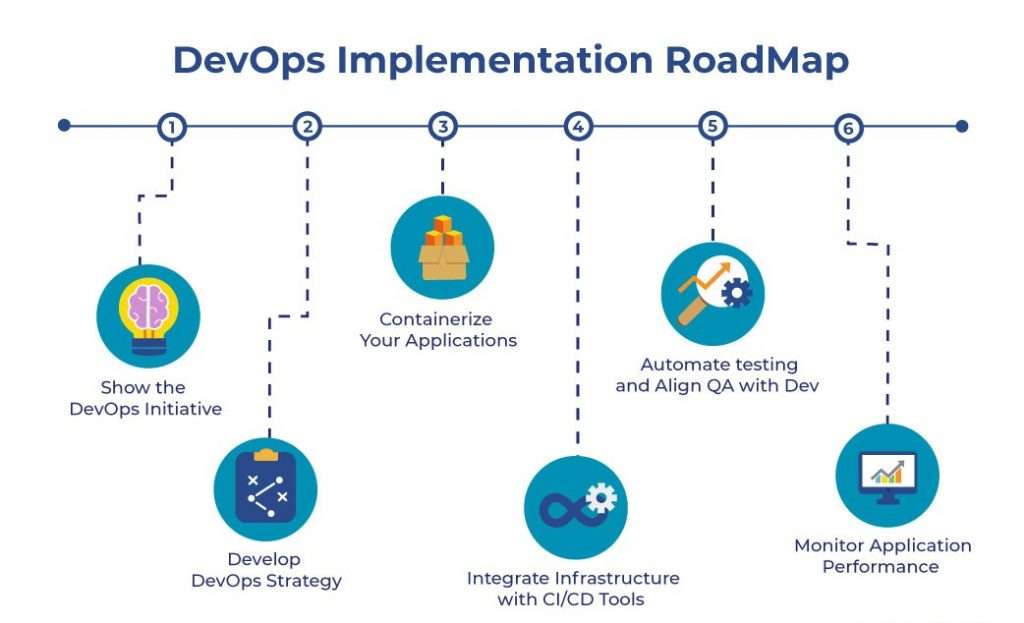
- Introduction to DevOps and Its Importance
- Continuous Integration (CI)
- Continuous Delivery (CD)
- Infrastructure as Code (IaC)
- Monitoring and Logging
- Collaboration and Communication
- How to Implement These DevOps Practices Effectively
- The Importance of Security in DevOps (DevSecOps)
- Measuring the Success of DevOps Implementation
- The Future of DevOps: Evolving Trends and Innovations
- Conclusion
Introduction to DevOps and Its Importance
With the fast-paced nature of the modern digital era, software development teams are constantly challenged to produce quality products in record time, with less error and greater agility. This pressure has given birth to DevOps, a philosophy and practice that seeks to bridge the gap between software development (Dev) and IT operations (Ops). By integrating development and operations, DevOps enables organizations to achieve continuous delivery, rapid deployment, and a faster time-to-market. This article will explore five core DevOps principles and practices that can significantly boost development efficiency. Additionally, Devops Training plays a crucial role in equipping professionals with the right skills to implement these practices effectively. Whether you’re just starting with DevOps or looking to refine your existing processes, these principles can help streamline your workflow, improve collaboration, and optimize performance. DevOps is not just a set of tools but a culture and mindset that aims to improve collaboration between development and operations teams. It advocates the automation of manual processes, emphasizes continuous feedback, and focuses on high-quality, repeatable results.
By adopting DevOps practices, organizations can:
- Increase Development Speed: Automation and streamlined processes enable faster software delivery.
- Enhance Collaboration: DevOps fosters collaboration between development, operations, and quality assurance teams.
- Improve Quality: Continuous testing and monitoring improve the quality and stability of the application.
Continuous Integration (CI)
Continuous Integration (CI) is one of the most essential DevOps principles. It refers to automatically integrating code changes from multiple developers into a shared repository frequently, ideally multiple times a day. CI helps reduce integration problems, improves collaboration, and speeds up development.
Key benefits of Continuous Integration:
- Faster Feedback Loops: Developers receive immediate feedback about the quality of their code, enabling them to fix issues early.
- Scalable Load Balancing: Microsoft azure application gateway can scale automatically based on traffic demand, optimizing resource utilization without manual intervention.
- Automated Testing: With each integration, automated tests are run to catch bugs or regressions before they reach production.
- Fewer Conflicts: Smaller, more frequent integrations mean fewer merge conflicts and more straightforward resolution.
How to Implement CI:
- Use CI tools like Jenkins, GitLab CI, or CircleCI to automate code integration and testing.
- Integrate unit tests, integration tests, and security scans into the CI pipeline.
- Ensure code is regularly committed to the repository to keep integration cycles short.
Excited to Achieve Your Devops Certification? View The Devops Training Offered By ACTE Right Now!
Continuous Delivery (CD)
Continuous Delivery (CD) extends CI by automating the deployment process. With CD, code is integrated and automatically pushed to staging or production environments, ensuring that the software is always deployable. This allows for faster and more frequent releases, enabling businesses to deliver features to users quickly.
Key benefits of Continuous Delivery:
- Rapid Delivery of Features: By automating the deployment pipeline, teams can release updates more frequently, allowing faster feature delivery.
- Improved Software Stability: Frequent releases with minor changes reduce the risk of bugs and downtime in production.
- Quick Rollbacks: In case of issues, you can quickly roll back to the previous stable release.
How to Implement CD:
- Use tools like jenkins pipeline , Travis CI, or Azure DevOps to automate the deployment pipeline.
- Ensure that all tests, including functional, performance, and security tests, pass before deployment.
- Set up environments for continuous testing, staging, and production to facilitate smooth transitions.

Infrastructure as Code (IaC)
Infrastructure as Code (IaC) is a practice where infrastructure is managed and provisioned using code rather than manual configuration. With IaC, infrastructure setups are automated, repeatable, and version-controlled, significantly improving your infrastructure’s scalability, consistency, and reliability.
Key benefits of Infrastructure as Code:
- Consistency: IaC ensures the infrastructure is always in the same state, reducing configuration drift and errors.
- Scalability: Infrastructure can be easily scaled up or down by adjusting the code without manual intervention.
- Disaster Recovery: With IaC, your entire infrastructure can be recreated from scratch if needed, making it easier to recover from disasters.
How to Implement IaC:
- Use Terraform, Ansible, or AWS Cloud formation to define and provision infrastructure.
- Store infrastructure code in version control systems, such as Git, to keep track of changes and rollbacks.
- Automate environment provisioning in your CI/CD pipeline to ensure consistency across environments.
- Start Small: Begin with small, manageable changes and gradually scale your DevOps practices across the organization.
- Automate as Much as Possible: Automation is the key to DevOps efficiency. Automate everything from code testing to infrastructure provisioning to deployment.
- Foster a DevOps Culture: DevOps is not just about tools; it’s about people. Promote collaboration, communication, and shared responsibility across teams while leveraging Devops automation tools to streamline processes and enhance efficiency.
- Monitor Continuously: Don’t just monitor your systems; monitor the effectiveness of your DevOps practices. Adjust and refine your processes as needed.
- Iterate and Improve: DevOps is an ongoing journey. Continuously improve your workflows, practices, and tools to align with evolving business needs and technology.
- Deployment Frequency: Measures how often code is deployed to production, indicating the agility and speed of the development cycle.
- Lead Time for Changes: The time it takes to go from committing code to having it deployed in production. Shorter lead times indicate more efficient development processes.
- Mean Time to Recovery (MTTR): The time it takes to recover from failures. A lower MTTR means that issues are detected and fixed faster.
- Change Failure Rate: The percentage of deployments that result in failures. A lower change failure rate indicates a more reliable deployment process.
- Use monitoring tools like Prometheus, Grafana, and New Relic to track key metrics. Regularly conduct post-incident reviews to analyze failures and identify opportunities for improvement. Implement feedback loops from both developers and operations to improve processes continuously.
Thrilled to Achieve Your Devops Certification? View The Devops Online Training Offered By ACTE Right Now!
Monitoring and Logging
Monitoring and logging are crucial for ensuring the health and stability of your applications. In a DevOps environment, monitoring provides insights into system performance while logging tracks events, errors, and application activity. Together, they enable teams to detect, diagnose, and resolve issues faster, improving development efficiency and user experience. Monitoring tools help detect anomalies before they become critical, allowing teams to fix problems proactively. Logs provide detailed information that can help quickly identify the root cause of issues. You can optimize the application for better speed and reliability by monitoring performance metrics. Use monitoring tools such as Prometheus, Datadog, or New Relic to monitor system performance, uptime, and key metrics. Implement centralized logging using tools like ELK Stack (Elasticsearch, Logstash, Kibana), Splunk, or Fluentd for efficient log aggregation and analysis. Set up alerts to notify teams of critical events or thresholds that require attention, ensuring they stay informed and responsive during Devops Training .
Collaboration and Communication
At its core, DevOps fosters collaboration between development, operations, and other teams involved in the software lifecycle. DevOps emphasizes a culture of shared responsibility, communication, and transparency, helping eliminate silos and promoting a more cohesive team environment. Open communication helps teams quickly share information and make informed decisions. Collaboration between cross-functional teams helps generate creative solutions to complex problems. With shared responsibility for the entire application lifecycle, teams own development and operational issues. Adopt collaborative tools like Slack, Microsoft Teams, or Jira to improve team communication. Conduct regular standups and retrospectives to ensure everyone is aligned and address any roadblocks. Foster a knowledge-sharing culture through internal wikis, documentation, and pair programming.

How to Implement These DevOps Practices Effectively
Implementing DevOps practices requires both cultural and technical changes. Here are some tips to ensure effective implementation:
Exploring Options for Devops Master’s Degree? Enroll For Devops Master Course Today!
The Importance of Security in DevOps (DevSecOps)
Security is often a concern in traditional software development, and DevOps is no different. However, integrating security into the DevOps pipeline known as DevSecOps ensures that security is addressed continuously and proactively at every stage of the software development lifecycle. With security integrated into the development process, vulnerabilities are identified and mitigated early. Continuous security testing helps minimize security gaps that could lead to data breaches or attacks. Ensures that the software adheres to regulatory standards and industry security best practices.Integrate automated security tests into the CI/CD pipeline. Use security scanning tools like Snyk, OWASP ZAP, or Aqua Security to identify vulnerabilities in code and containers. Educate development teams about secure coding practices and the importance of security in DevOps.
Measuring the Success of DevOps Implementation
To ensure that DevOps practices are having the desired effect, it’s crucial to monitor performance and measure key metrics. By tracking progress and evaluating the success of DevOps initiatives, organizations can continuously refine their processes. Code quality with ci/cd integration plays a vital role in this by ensuring that every code change is automatically tested and validated, leading to more reliable software delivery.
Key Metrics to Track:
How to Measure DevOps Success:
Preparing for Your Devops Interview? Check Out Our Blog on Devops Interview Questions & Answer
The Future of DevOps: Evolving Trends and Innovations
As technology advances, DevOps continues to evolve with emerging trends and innovations shaping the future of software development and operations. The rise of AI and machine learning in DevOps (AIOps) is enabling automated anomaly detection, predictive analytics, and intelligent incident management, reducing downtime and improving efficiency. Additionally, GitOps a declarative approach using Git as the single source of truth for infrastructure and applications—is gaining traction, enhancing version control and automation. The increasing adoption of serverless computing and Kubernetes is further streamlining deployment and scalability. By staying ahead of these trends, organizations can continue to refine their DevOps strategies, increase agility, and maintain a competitive edge in an ever-changing digital landscape.
Conclusion
Adopting DevOps principles and practices is crucial for organizations aiming to enhance development efficiency and remain competitive in today’s fast-paced market. By embracing Continuous Integration (CI), Continuous Delivery (CD), Infrastructure as Code (IaC), Monitoring and Logging, and Collaboration, development teams can deliver high-quality software more quickly, reduce operational issues, and promote a culture of continuous improvement. Implementing CI/CD pipelines ensures that code is frequently integrated and delivered, which reduces manual intervention and accelerates deployment. IaC allows for the automation of infrastructure management, ensuring consistency and scalability. Effective monitoring and logging help identify issues early, minimizing downtime and improving system reliability. Lastly, fostering collaboration between development and operations teams breaks down silos and enhances communication. By committing to these core DevOps principles, investing in Devops Training , and making continuous improvements, organizations can unlock the full potential of DevOps. This approach accelerates development processes, drives innovation, enhances product quality, and supports business success.





